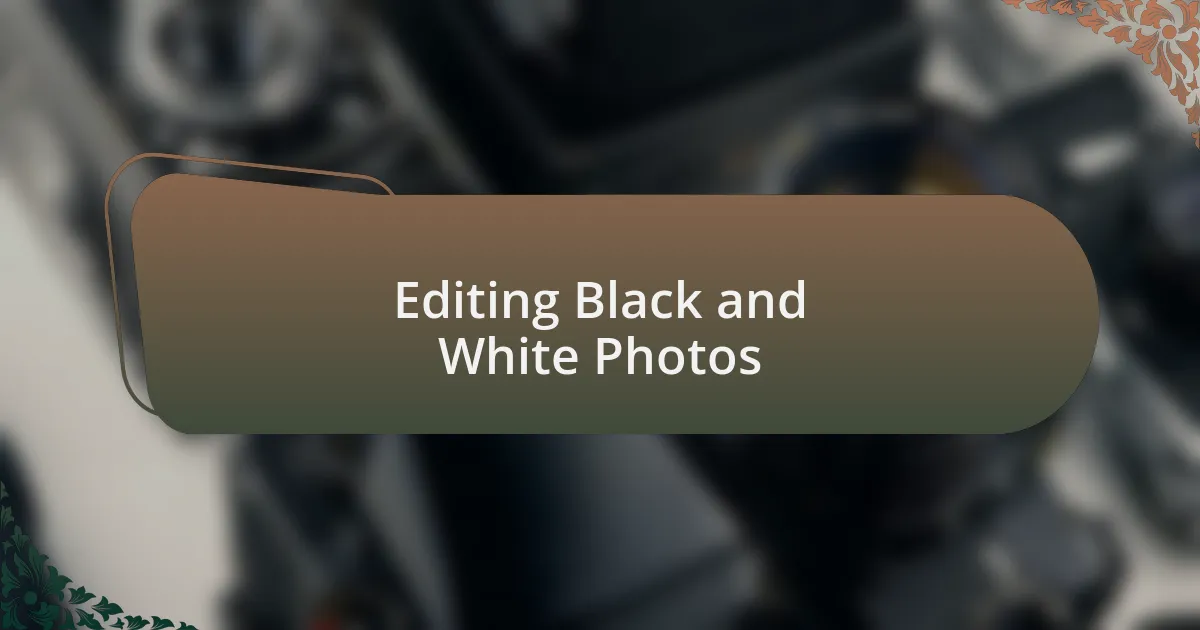Key takeaways:
- Black and white photography emphasizes contrasts, shapes, and emotions, stripping away distractions and evoking nostalgia.
- Street portraits connect viewers to the subject’s humanity and can highlight social issues, conveying deep emotional narratives.
- Effective techniques for capturing emotion include understanding body language, utilizing lighting, and engaging with subjects to foster authentic connections.
- Editing black and white photos focuses on contrast, grain, and selective techniques to enhance the subject’s story and emotional impact.

Understanding Black and White Photography
Black and white photography holds a unique charm that speaks to the essence of the image rather than the distractions of color. I remember my first attempt at capturing a street scene in monochrome; the absence of color forced me to focus on contrasts, shapes, and emotions. Have you ever noticed how a simple expression can tell a profoundly different story when color is removed?
In my experience, black and white images often evoke a sense of nostalgia and timelessness. They strip away unnecessary elements, leading the viewer to engage more deeply with the subject. I once photographed a street performer, and the lack of color really emphasized the intensity in their eyes—their passion became the focal point, transcending the limitations of everyday distractions.
Shadows and highlights play a crucial role in black and white photography as they create depth and drama. I find it fascinating how the interplay of light can alter the mood and perception of a scene. Have you ever captured a moment where the light revealed hidden details? That’s the power of black and white—it invites us to see the world through a different lens, literally and figuratively.

Importance of Street Portraits
Street portraits serve as a bridge that connects the viewer to the subject’s humanity. I vividly recall a chilly afternoon, camera in hand, when I approached an elderly man sitting on a park bench. The way the light highlighted the lines on his face showed a lifetime of stories, capturing a moment that would have been fleeting in color but felt eternally poignant in black and white.
The beauty of street portraits lies in their ability to evoke emotions, often stripping away the distractions of modern life. I once snapped a quick photo of a young girl laughing with friends, and in that monochrome frame, her joy became an emblem of innocence. Can color truly convey such raw emotion? In my experience, it often falls short, leaving too much to interpretation.
Importantly, street portraits can highlight social issues, serving as a visual commentary on the world around us. I remember taking a picture of a homeless person on a bustling street corner; their gaze was captivating, drawing attention to a narrative that often goes unnoticed. Isn’t it remarkable how a single image can shift perspectives and foster empathy? This is the magic of street photography—it tells stories that resonate deeply with us all, regardless of our backgrounds.

Techniques for Capturing Emotion
Capturing emotion in black and white street portraits requires an acute sensitivity to the subject’s body language and facial expressions. I remember the moment I saw a man sitting alone on a city sidewalk, his eyes was filled with contemplation. That stillness, framed against the hustle of passing pedestrians, allowed me to freeze a moment where vulnerability spoke louder than words. Would a colorful backdrop have distracted from what I saw in his expression?
Lighting plays a pivotal role in evoking emotional depth. One evening, I positioned myself so that the soft, golden glow of the setting sun cascaded across a woman’s face, creating dramatic shadows that accentuated her features. The interplay of light and shade transformed her serene look into something profound, revealing layers of emotion that would have been lost in a brighter scene. How often do we overlook the power of light in storytelling?
Engaging with your subjects is another essential technique for capturing their true essence. I’ve approached strangers with a smile and a few open-ended questions, allowing them to share their stories. It was during one of these encounters that a young musician shared his struggles and dreams while I clicked away. The genuine connection we forged resulted in a photograph that radiated authenticity and emotion. Isn’t it fascinating how human connection can elevate a simple portrait into a powerful narrative?

Editing Black and White Photos
Editing black and white photos often begins with adjusting the contrast to bring out the depth in the shadows and highlights. I’ll never forget the first time I divided tones using a simple adjustment slider. That moment of discovery felt like unlocking a secret language; suddenly, my images had a new life, emphasizing textures and emotions that just didn’t pop in color. Isn’t it amazing how a simple tweak can make your subject’s story more compelling?
When I edit, I pay close attention to the graininess of the image. One day, I deliberately introduced a film-like grain to a portrait I took at a bustling street fair. The added texture not only imparted a vintage feel but also enhanced the mood, almost making me feel the noise and energy of the fair itself. Have you ever considered how grain can shift the emotional tone of your images?
Finally, I always explore selective editing techniques to draw attention to the subject’s eyes or expressions. For instance, I once brightened the eyes of a candid shot I took of an elderly woman lost in thought, which transformed the viewer’s connection to her story. The subtle detail of her gaze anchored the emotion—it’s like giving a voice to the unspoken feelings within the image. How can a slight edit influence the narrative your photos tell?